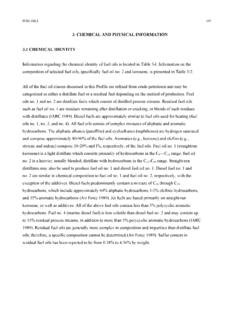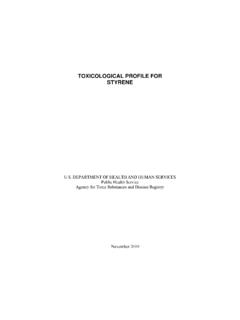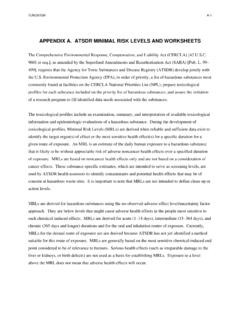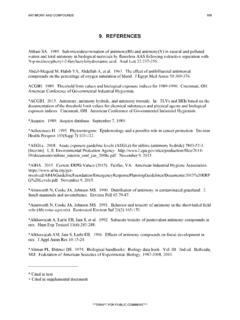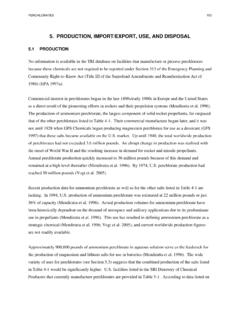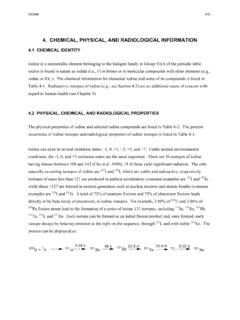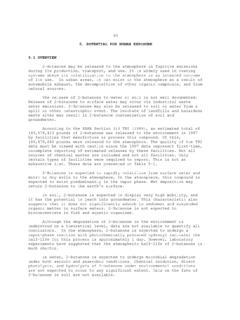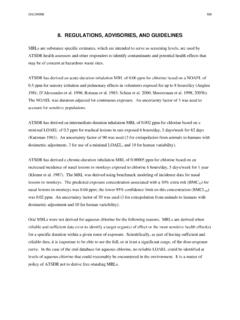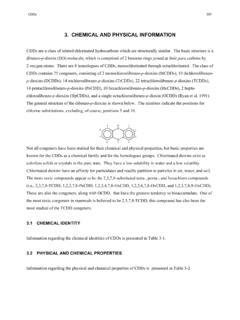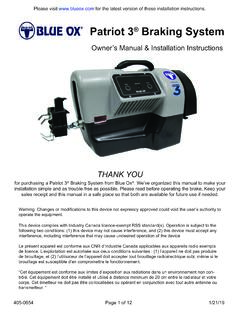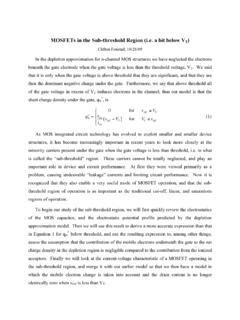Transcription of 7. ANALYTICAL METHODS - Agency for Toxic Substances and ...
1 AMMONIA 153. 7. ANALYTICAL METHODS . The purpose of this chapter is to describe the ANALYTICAL METHODS that are available for detecting, measuring, and/or monitoring ammonia, its metabolites, and other biomarkers of exposure and effect to ammonia. The intent is not to provide an exhaustive list of ANALYTICAL METHODS . Rather, the intention is to identify well-established METHODS that are used as the standard METHODS of analysis. Many of the ANALYTICAL METHODS used for environmental samples are the METHODS approved by federal agencies and organizations such as EPA and the National Institute for Occupational Safety and Health (NIOSH).
2 Other METHODS presented in this chapter are those that are approved by groups such as the Association of Official ANALYTICAL Chemists (AOAC) and the American Public Health Association (APHA). Additionally, ANALYTICAL METHODS are included that modify previously used METHODS to obtain lower detection limits and/or to improve accuracy and precision. BIOLOGICAL MATERIALS. When ammonia is found in biological materials at physiological pH ( ), most of it (99%) will be found as ammonium ion, due to its pKa of This is an important consideration for any subsequent analysis. The determination of ammonia (as dissolved NH3 and ammonium ion) in blood, plasma, or serum is of value in detecting existing or impending hepatic coma and Reyes Syndrome (Meyerhoff and Robins 1980; Tietz 1970).
3 The determination of ammonia in urine had historically been used as an indicator of the kidney's ability to produce ammonia; however, this procedure has been replaced by more modern and accurate tests for kidney function. Procedures for the determination of ammonia in biological samples are found in Table 7-1. Ammonia is also tested for in calculi (abnormal concretions in the body formed of mineral deposits, often found in the gall bladder, kidney, or bladder) (Tietz 1970); however, the test described therein is not quantitative and is not included in Table 7-1. The amount of ammonia in collected blood, urine, saliva, or other biological fluid samples can be affected by several mechanisms that may lead to erroneous ammonia concentration determinations.
4 These effects can be minimized by proper sample storage and handling. The ammonia content of freshly drawn blood rises rapidly on standing because of the deamination of labile amides such as glutamine (Henry 1964); at room temperature, the ammonia content can increase by a factor of two or three in several hours. Therefore, it is important to both keep the specimen cold (on ice) and perform the analysis as soon as possible. If the sample cannot be analyzed quickly, it may be frozen (-20 C). The ammonia content of AMMONIA 154. 7. ANALYTICAL METHODS . Table 7-1. ANALYTICAL METHODS for Determining Ammonia in Biological Samples Sample ANALYTICAL Sample Percent matrix Preparation method method detection limit recovery Reference Urine 24-Hour specimen, add Colorimetric Not reported Not reported Tietz 1970.
5 HCl, refrigerate (Berthelot reaction). Urine 24-Hour specimen Indophenol Not reported Not reported Huizenga et analyzed immediately, or reaction al. 1994. stored up to 8 weeks at -20 C. Saliva Freeze at -20 C for up to Membrane Not reported Not reported Huizenga et 2 weeks, or store for 1 hourbased al. 1994. at 4 C, or analyze ammonia- immediately selective electrode Serum, Freeze, then store at -15 C Colorimetric Not reported Not reported Huizenga et plasma, for several days, or store assay based al. 1994. whole blood on ice (4 C) for 30 on indophenol 60 minutes, or analyze production immediately Serum, Freeze, then store at -15 C Titration Not reported Not reported Huizenga et plasma, for several days, or store al.
6 1994. whole blood on ice (4 C) for 30 . 60 minutes, or analyze immediately Serum, Freeze at -30 C or store Membrane Not reported 14% error, Meyerhoff plasma, on ice, or analyze based 102% average and Robins whole blood immediately ammonia- recovery 1980. selective electrode AMMONIA 155. 7. ANALYTICAL METHODS . iced (4 C) blood samples remains constant for up to 60 minutes, whereas the ammonia content of frozen (-20 C) blood samples remains constant for several days (Huizenga et al. 1994; Tietz 1970). For blood samples collected from a healthy person (and stored on ice), the ammonia content should be measured within 30 60 minutes of collection.
7 For persons suspected of suffering from liver disease, however, the blood samples should be analyzed within 15 minutes (Huizenga et al. 1994). This more rapid assessment is necessary because some liver diseases result in high levels of -glutamyl transferase, an enzyme that hydrolyzes glutamine; the enzyme's activity will increase the concentration of ammonia in the sample to levels higher than was present at the time of collection (Huizenga et al. 1994). Other erroneously high measured ammonia levels can result from ammonia contamination of reagents or pick-up of ammonia from the atmosphere, including from technicians that have recently smoked a cigarette (Huizenga et al.)
8 1994). The presence and activities of bacteria in samples can also cause changes in the concentrations of ammonia. The natural presence of bacteria present in some samples ( , saliva) or their presence in infected tissues ( , bladder infections) can lead to erroneously high ammonia concentrations, due to the presence of bacterial ureases that hydrolyze urea present in the biological samples. This reaction is the chief cause for the formation of ammonia in unacidified urine on standing (Henry 1964). Furthermore, contamination of samples by environmental bacteria following the collection of the sample may also lead to increases in ammonia concentrations.
9 Therefore, use of sterile collection bottles for sample collection and storage is recommended if there is potential for storage of the sample prior to analysis (Huizenga et al. 1994). In the determination of ammonia or ammonium ion in biological samples, ammonia is first liberated by distillation, aeration, ion-exchange chromatography, microdiffusion, or deproteinization (Huizenga et al. 1994). Deproteinization METHODS involve treatment of blood or plasma fluids with trichloroacetic acid (or perchloric acid or tungstate-sulfuric acid), followed by centrifugation. The protein-free supernatant can be assayed colorimetrically for ammonia.
10 Traditionally, Kjeldahl distillation METHODS have been used to determine ammonia levels in biological tissue, but other METHODS ( , colorimetric or ion-specific electrodes) are also available. In the Kjeldahl distillation, ammonia is distilled and subsequently trapped in acid and analyzed titrametrically or colorimetrically. High values sometimes result because of the cleavage of protein amino groups and also the formation of ammonia by deamination reactions (Parris and Foglia 1983). Other techniques use the ammonia-selective electrode and enzymatic assays. Discrepancies have been reported between results using electrodes and those using more specific enzymatic procedures because the ammonia electrode responds to both ammonia and volatile amines (Parris and Foglia 1983).
